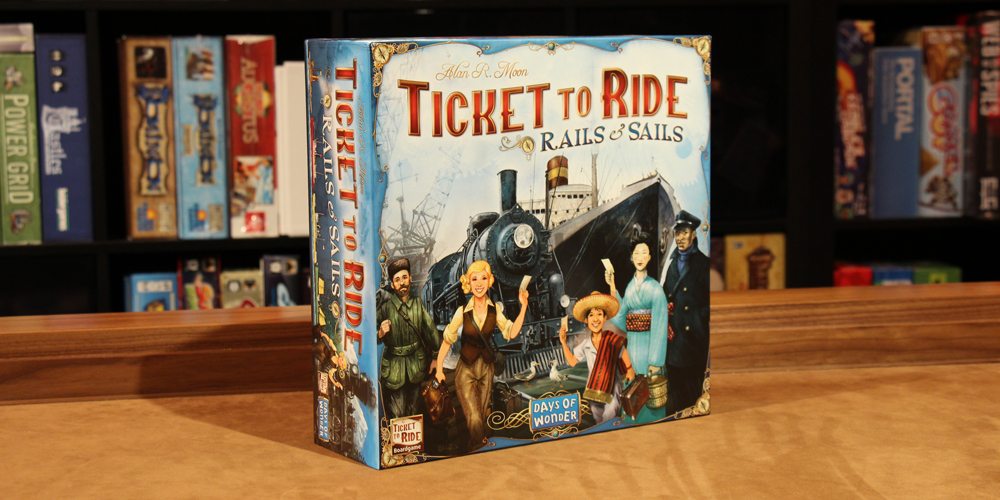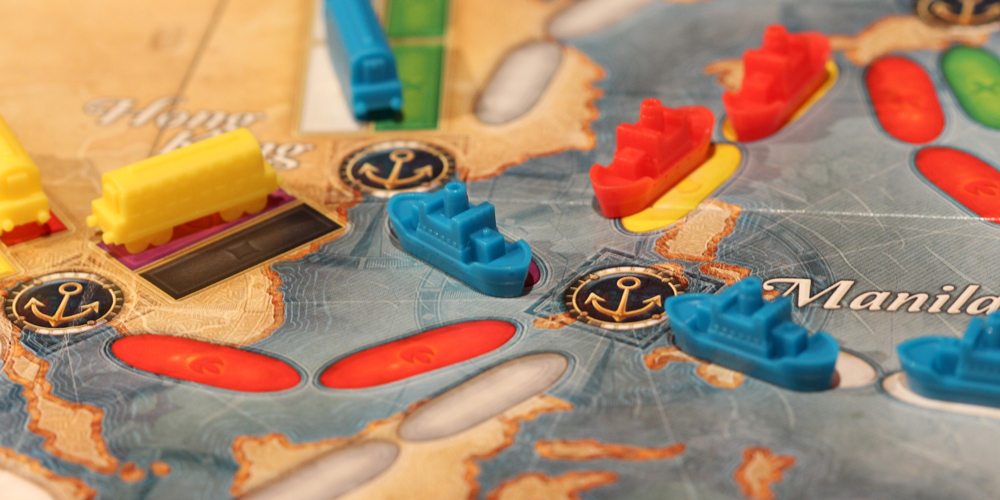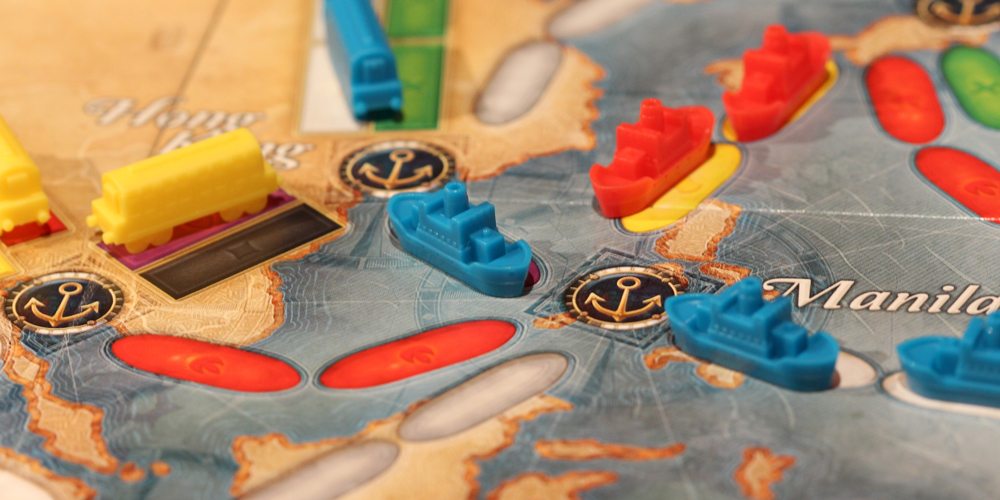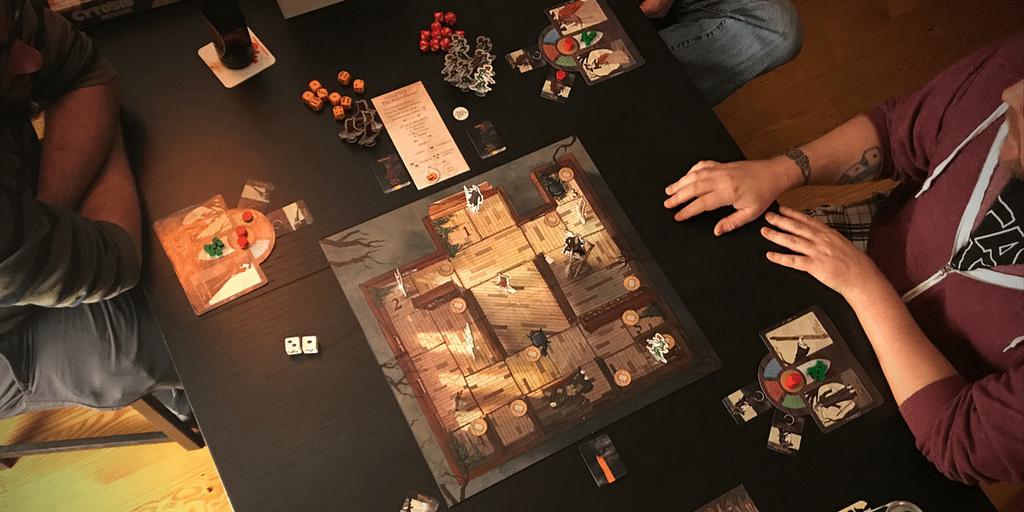
Ticket to Ride has long been the train game to play. It’s on almost everyone’s gateway game list and it’s a heckuva lot of fun. The latest iteration of the game, coming to stores this week, is Ticket to Ride: Rails and Sails, a double mapped, stand-alone game that features not just trains, but ships too. With two maps and two types of travel, it’s two games in one–in more ways than just one.
There’s a lot of familiarity here–the big board, plentiful components, and a mostly known ruleset–and for that reason, we’re not going to go into great detail about the components and rules, like we normally do in our game reviews. That’s mostly because so many people know Ticket to Ride.

But briefly, we’ll talk about what’s in the box. There’s the huge board that’s double-sided, the world on one side (with routes wrapping from one side to the other) and the Great Lakes on the other. There are 260 cards, including 80 train cards, 60 ship cards (both trains and ships in just six colors/types), 65 tickets for the world, and 55 tickets for the Great Lakes. There’s a small mountain of plastic tokens. For each of the five player colors, there are 25 trains, 50 ships, 3 harbors, plus a wooden scoring marker. Before getting into the differences in tickets and rules, it’s interesting that, despite being called Rails and Sails, the plastic ships are steamers, not masted ships. It’s addressed in the travel cards, but still…

In both versions of this game, each player is given a number of ship and train tokens and forced to decide how many of each to keep to meet a pregame limit before play begins. It’s up to the player to decide the mix, but she can later swap trains for boats (or the opposite) later in the game for a point penalty.
Players are dealt a number of travel cards and tickets and play begins in known Ticket to Ride fashion, with a few minor tweaks. Players can take travel cards from the supply, claim routes, or draw tickets. Additionally, players can build harbors or exchange pieces.
In order to place a harbor, a player must have a route placed going into the city he wishes to build the harbor in. Naturally, the harbor can only be placed at a city on the water, which are noted by anchor symbols on the board. Only one harbor can be placed per city and in order to place it, a player must have two ship and two train cards, all of the same color (wild cards count) and each with a harbor’s anchor symbol on the card.

It’s important to place harbors before the end of the game because they can be very valuable. You lose four points for each harbor not placed, but each one you do manage to get on the board pays big dividends. If your harbor has a single completed ticket of yours going into it, the harbor is worth 20 points at the end of the game. Two completed tickets earns 30 points and three or more completed tickets throws off 40 points. Those are game-changing outcomes.
The other option, to exchange pieces, is pretty straight forward. On her turn, a player can pay a point for each piece she wants to exchange. For example, a player needs a few more ships to complete a route. On her turn, she turns in three trains, gets three ships in return, and pays a penalty of three points.
On the cards there are a few differences too. On the travel cards, there are the harbor designations. Wild cards, although they come exclusively from the train portion of the travel deck, can be used for either train routes or ship routes. Some ship travel cards have double boats on them, meaning they count for (up to) two spaces on a route. Trains and ships may both be necessary to complete a route that spans both land and sea.

In the world version of the game, the ticket cards have eight special Tour tickets, which map out a route across a great distance. There are three values on the cards, one showing the reward if the route is completed as shown on the card. There’s a second, lower value that the player will earn if he completes the route, but not exactly as shown on the card. Finally, there’s a third value that shows the value the player will lose by not completing the Tour card. This last number is always larger than the reward for completing the card, sometimes by quite a bit more.
Additionally, on the world map, there are a few routes that go over mountainous areas and are marked as difficult terrain. To fill these, each space on the route must be filled by a pair of matching travel cards. That is, a route that is two spaces long requires two pairs. This could be four red trains, two orange and two black, or variations like that.
The game ends when one player reaches six or fewer combined train and ship tokens, then each person gets two more turns. At that point, the score is tallied. Current score is added with completed tickets (and incomplete tickets subtracted), harbors are added and incomplete harbors are subtracted. There are no bonuses, most points wins.

After a few plays, my family feels like Rails and Sails might be our new favorite Ticket to Ride game, for several reasons. First, the map is sized just right that, no matter what the number of players you are playing with, space seems somewhere between just right and not enough (toward the end of the game). This makes for a challenging game.
Second, learning to manage and balance ships and train tokens and ship and train travel cards adds enough complexity to the game to make it feel like a real step up, regarding difficulty and strategy. This game is still rated for players 8 and up, but I wouldn’t be surprised if some 8 year olds had a tough time looking far enough ahead to know how many tokens to need and which type of cards to draw.

Third, we really like the differences in the cards. Double ships and Tour cards make it tougher to guess what your opponent is doing and allow you to score more with fewer cards. The harbors, however, give less away, since you can see how many routes your opponent has going into his harbor (allowing you to make some assumptions about his end score). Still, the Tour cards and harbors have great potential for point upheaval at the end of the game.
Like all Days of Wonder games, Ticket to Ride: Rails and Sails has great, high quality components, a well-thought out box insert, and is a joy to play. Ticket to Ride: Rails and Sails is available now.

Disclosure: GeekDad was provided with a copy of this game for review purposes.





What size are the cards? I make card and deck holders for TTR games, and I’d like to make a deck holder for this new version, but I want to make sure the card stalls are wide enough. Thanks!
All ticket and train/ship cards are standard bridge size, 2.25 x 3.5 (approx).